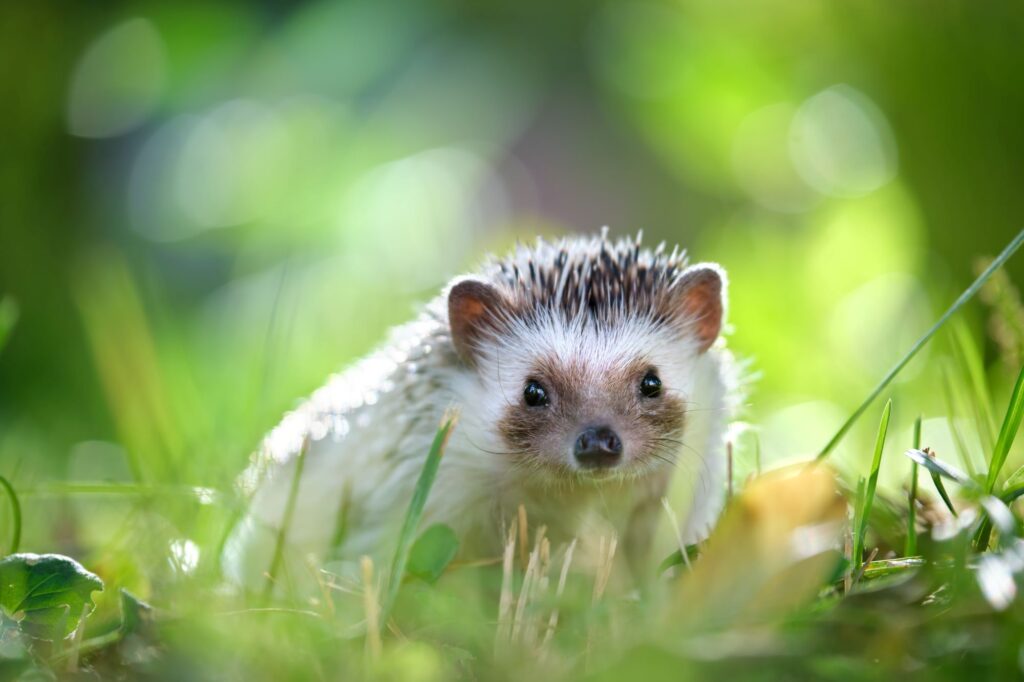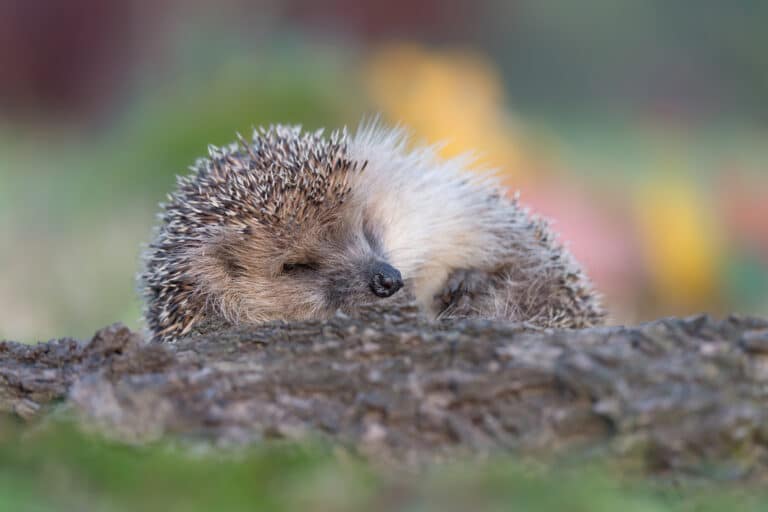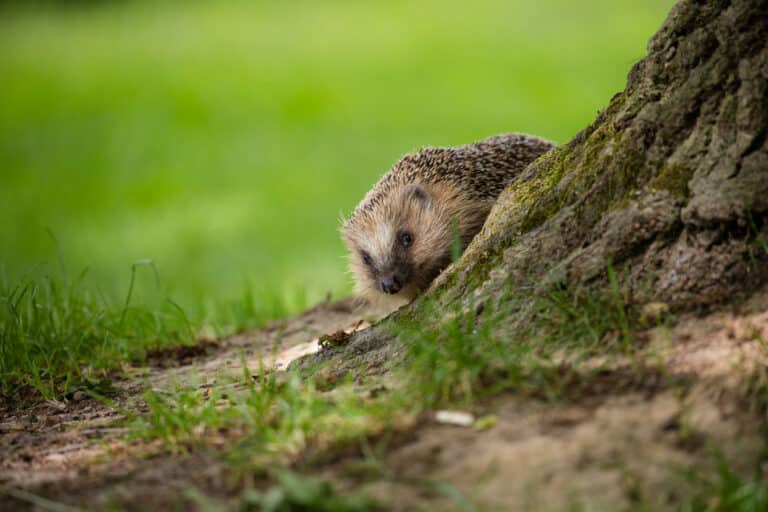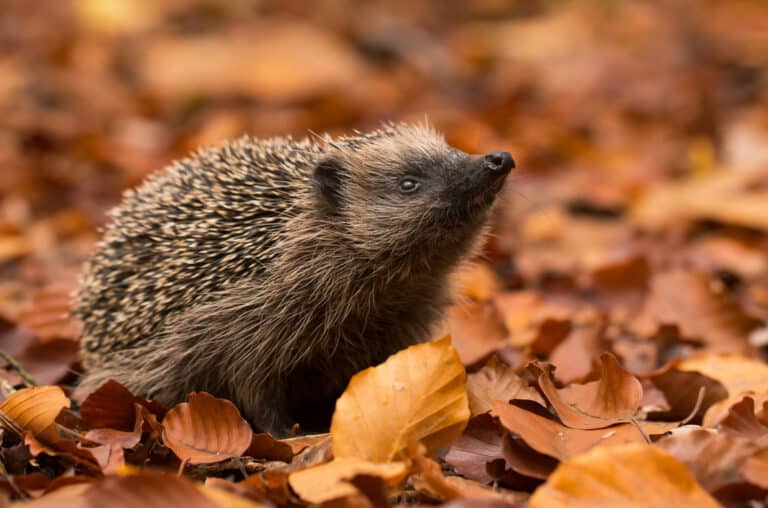Facts about the European Hedgehog
Scientific name: Erinaceus europaeus
At a glance
- Found across a wide range of rural and urban habitats, preferring woodland edges and hedgerows.
- Many sites in England and Wales that reported hedgehogs in the 1980s had stopped reporting them by the 1990s.
- Following long-term declines here hedgehogs were Red-listed as Vulnerable to extinction in 2020.

One of seventeen broadly similar-looking species of hedgehog found across Europe, the Middle East, Africa and Central Asia, the European Hedgehog, with its protective coat of several thousand spines, brown pointed furry face, and small black eyes and nose, is instantly recognisable and well-loved (by most of us anyway).
Hedgehogs can be found across a wide range of rural and urban habitats, preferring woodland edges and hedgerows where there is plenty of food for them. They are absent from moorland, coniferous plantations, and wetlands. Hedgehogs eat beetles, worms, caterpillars, slugs and almost anything they can catch, but not much in the way of plant material. They can also take eggs and chicks of ground-nesting birds though rarely in large numbers and much less so than foxes and crows – putting them at odds with gamekeepers: writing in Country Life in 2013, one said that he’d known “rogue hedgehogs to kill pheasant poults. They’re also efficient predators of the eggs of partridges and other ground-nesting birds.”
Gamekeepers complaining about native hedgehogs eating pheasant eggs seems a long way from the Hebrides and non-native hedgehogs eating rare waders eggs, but that same taste for eggs has – controversially – put Hedgehogs at odds with conservationists. Essentially mainland animals Hedgehogs have been introduced to a number of islands where they have no natural predators, including, in 1974, South Uist in the Hebrides. Originally just seven were released, supposedly to control slugs. From there they did what many introduced animals have done before them: they expanded, spreading to Benbecula and North Uist, and started attacking the native fauna.
The Outer Hebrides is home to internationally important populations of wading birds that nest on coastal grassland. Research in the 1980s and 1990s noted that declines in these bird populations was largely due to egg predation by Hedgehogs. Over four years, hundreds of Hedgehogs were given lethal injections, but after pressure from activists the ‘cull’ was dropped in favour of translocation. Using live cage traps and trained sniffer dogs has shown to be a very effective means of finding and catching hedgehogs. Caught animals are passed into the care of Uist Hedgehog Rescue and moved to the Scottish mainland.

One of seventeen broadly similar-looking species of hedgehog found across Europe, the Middle East, Africa and Central Asia, the European Hedgehog, with its protective coat of several thousand spines, brown pointed furry face, and small black eyes and nose, is instantly recognisable and well-loved (by most of us anyway).
Hedgehogs can be found across a wide range of rural and urban habitats, preferring woodland edges and hedgerows where there is plenty of food for them. They are absent from moorland, coniferous plantations, and wetlands. Hedgehogs eat beetles, worms, caterpillars, slugs and almost anything they can catch, but not much in the way of plant material. They can also take eggs and chicks of ground-nesting birds though rarely in large numbers and much less so than foxes and crows – putting them at odds with gamekeepers: writing in Country Life in 2013, one said that he’d known “rogue hedgehogs to kill pheasant poults. They’re also efficient predators of the eggs of partridges and other ground-nesting birds.”
Gamekeepers complaining about native hedgehogs eating pheasant eggs seems a long way from the Hebrides and non-native hedgehogs eating rare waders eggs, but that same taste for eggs has – controversially – put Hedgehogs at odds with conservationists. Essentially mainland animals Hedgehogs have been introduced to a number of islands where they have no natural predators, including, in 1974, South Uist in the Hebrides. Originally just seven were released, supposedly to control slugs. From there they did what many introduced animals have done before them: they expanded, spreading to Benbecula and North Uist, and started attacking the native fauna.
The Outer Hebrides is home to internationally important populations of wading birds that nest on coastal grassland. Research in the 1980s and 1990s noted that declines in these bird populations was largely due to egg predation by Hedgehogs. Over four years, hundreds of Hedgehogs were given lethal injections, but after pressure from activists the ‘cull’ was dropped in favour of translocation. Using live cage traps and trained sniffer dogs has shown to be a very effective means of finding and catching hedgehogs. Caught animals are passed into the care of Uist Hedgehog Rescue and moved to the Scottish mainland.

The project is still ongoing and has cost hundreds of thousands of pounds – all because someone had a terrible grasp of ecology and hadn’t read any articles on what happens when seemingly harmless animals are released into an ecosystem that’’s not adapted to them. Like many unwitting invaders before them, it turns out that Hedgehogs are remarkably resilient given enough food and shelter: in June 2022, islanders on neighbouring Barra were urged to be vigilant after the first Hedgehog ever seen there was found dead on the road.
Hedgehogs don’t – sadly – always do so well in landscapes they’re supposed to be in. Enormous habitat changes have taken place across the UK, especially on farmland which is also often doused with a cocktail of pesticides that kills their prey. Many sites in southwest England and Wales that reported hedgehogs in the 1980s had stopped reporting them by the 1990s. Since 1990, counts of hedgehog road casualties have fallen by around three-quarters. In 2018, The Mammal Society estimated the Hedgehog population to be around 879,000, but acknowledged that surveying a small nocturnal animal meant there was considerable uncertainty in the figure. After what appeared to be long-term declines, Hedgehogs were put on the IUCN Red List as vulnerable to extinction in Great Britain in 2020.
Which (perhaps surprisingly) brings us back to gamekeepers and landowners, who have recently developed a hitherto unsuspected passion for Hedgehogs because the declines allow them to scapegoat Badgers, which they claim since the Protection of Badgers Act have been overrunning the countryside, destroying dairy herds – and eating Hedgehogs.
The (perhaps inconvenient as it doesn’t fit the narrative of the ‘countryside manager’) truth is that while Badgers will eat hedgehogs, they are most abundant in lowland pastoral landscapes where Hedgehogs are comparatively scarce. The two species do compete for food, such as earthworms and beetle larvae, but when they are foraging, Hedgehogs tend to avoid areas where Badgers have recently been active. The two species have evolved alongside each other and in areas with lots of Badgers, they can co-exist; even more pertinently in a national survey, Hedgehogs weren’t found in 71% of rural sites where there were no Badger setts.

Declines in most animals are multi-factorial and that certainly appears to be the case with the Hedgehog. A summary concluding the “State of Britain’s Hedgehogs 2022” report summed up the situation far more intelligently than pointing the finger at Badgers, and (uncomfortably for those same ‘countryside managers’) outlined the ways that massive changes to (particularly) the farmed environment were impacting Hedgehogs.
“Foremost of the pressures that hedgehogs face is an impoverished environment. We also need to look at other aspects of the countryside: at the management of field margins and soils, and the number and abundance of invertebrate species; at connectivity in the landscape, linking habitats and populations; at climate change; and at the interaction of species in a changing environment. The continuing loss of a generalist species such as hedgehogs, like that of farmland songbirds, is the ‘canary in the coal mine’. To stop it, we need to recognise the essential value of biodiversity, our dependence on the tapestry of natural habitats and species. That tapestry is becoming threadbare. Even if you care little about hedgehogs, we should all care about the nature that supports them and us.” David Wembridge, Grace Johnson, Nida Al-Fulaij & Steve Langton
